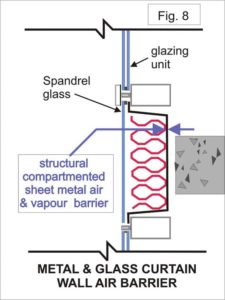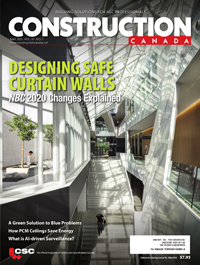Structural Requirements of the Air Barrier Explained

Examples of structural compliant air barrier systems include many precast cladding system, metal and glass curtain walls, and concrete shear walls. Other air barrier compliant parts of assemblies may include;
• the gasket and gypsum board air drywall approach (ADA) for residential wood frame buildings (Figure 4);
• the external air system element (EASE) air barrier system for the exterior side of wood framed buildings which consists two layers of vapour permeable fibreboard with a breather (vapour permeable) construction paper (Figure 5, page 28);
• other examples of composite assemblies for air barrier systems using panels and membranes may include gypsum board, polyethylene film, and gypsum board sandwiched on steel stud (Figure 6);
• precast cladding with drained and vented joint (Figure 7);
• curtain wall system with compartmented air barrier (Figure 8);
• sheet steel liners mechanically attached to girths and sub-girts with gasket joints;
• an asphalt membrane thermo-fused over a block wall is an acceptable mechanical connection to the block;
• peel and stick membranes between two structural panels; and

• many others as well.
Each of these examples will require structurally designed connections at joints between panels and at connections to other systems. The most important connections to resolve are the roof-to-wall connection (also known as the parapet), connections between different exterior wall cladding systems particularly at corners, overhangs and balconies, and other locations.
Conclusion
As noted, the progress in air barrier design and construction in 2021 is lopsided and incomplete. The structural design issue for the air barrier remains unresolved with a few exceptions, metal and glass curtain walls and precast cladding.
It will be incumbent on the industry of professionals, building officials and educators to take note of this serious deficiency if building envelope performance is to advance into the new century. There must be a significant change to the application of the air barrier science and technology of the building envelope to incorporate the structural requirements of the NBCC Part 5, section 5.3. on air barriers. Here are a few thoughts and ideas to consider.
Rick Quirouette, B.Arch., is a senior building science specialist with almost four decades of experience in building science and technology. He is a life member of the Alberta Building Envelope Council (ABEC) and a past-president of the National Building Envelope Council (NBEC). Operating as Quirouette Building Specialists Ltd., he can be reached at rickquirouette@gmail.com.







